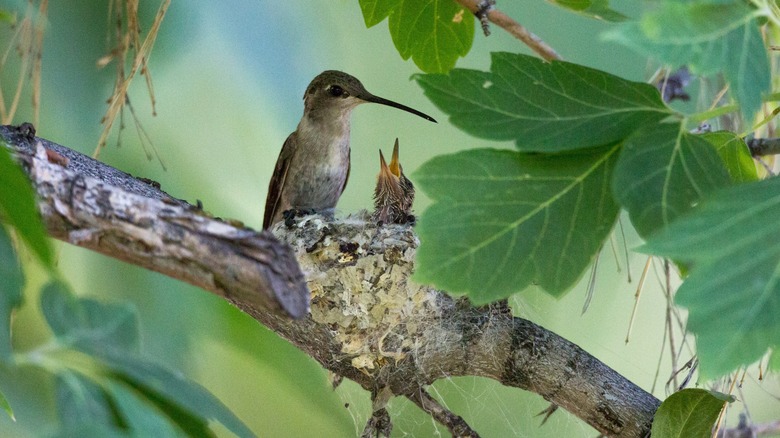Hummingbird Nests Are Hard To Spot, But Here's What To Look Out For
Even if you have a garden buzzing with these tiny birds, you may have never seen a hummingbird nest before. Spotting their nesting site can be like finding a needle in a haystack. However, if you're patient and know what to look for, you can uncover these hidden gems. Known for their vibrant feathers and quick-flying skills, hummingbirds are also highly adept at building nests that camouflage with their surroundings. Measuring only a little over 1 inch in diameter, their tiny homes typically look like another knot or bump in the branches. Not only is it hard for humans to see where they're hiding their young, but predators also struggle to spot the hatchlings. Hidden under patches of leaves, their eggs stay shielded from the elements as well.
Hummingbirds build their nests at different times of the year, depending on their location. Breeding season can be as early as spring in southern areas of the U.S., while it may not kick off until summer in colder locations. The best way to start your investigation is to observe hummingbird behavior in your yard. Sometimes spending a week meticulously building, the mom will fly back and forth to the same spot as she adds to the nest. Because they nest near food, watching their flight patterns in areas close to flowers that hummingbirds absolutely love may help you locate her construction site. Watch from afar; if she senses you're tracking her, she might lead you away from the nest.
Look for nests in dense shrubs with plenty of foliage
Hummingbird moms are diligent in every step of the nest-building process. They typically choose a spot at the edge of a yard for safety, or near water sources that keep the area cool. Building between 10 to 90 feet high in shrubs or trees, she carefully chooses a location that will best keep her brood out of harm's way. Dense bushes with good foliage coverage are prime real estate to cover her tiny young, keeping them safe from rain and wind. Plants with thorns are even better, as they make a more imposing barrier for cats, snakes, and other predators that could be eating hummingbirds in your yard. These small fliers prefer thin, forked branches of deciduous trees about a foot from the trunk. However, some species, such as broad-billed hummingbirds, may even build nests on other items, like clotheslines.
Transforming your garden into a hummingbird-friendly paradise will increase the odds of nesting, giving you a better chance of getting to see her natural creations. These clever aviators tend to remember locations that have everything they need. So, yards with several nutrition sources, including feeders and flowers, and water, such as a hummingbird bath, make it a more enticing spot to raise their young. Adding perching areas, like hummingbird swings, is another appealing way to attract hummingbirds to your garden. That said, one place you'll never find a female housing offspring is in a birdhouse, because they're naturally inclined to construct open cup nests, not enclosed spaces.
Look more closely at oddly-placed knots
Although there are over 360 hummingbird species in the Americas, there are just 15 types you'll find in the United States. Each unique species has different breeding habits, though they all share a few commonalities with their nest-building technique. Taking up to a week to perfect their small abodes, the female hummingbird uses natural plant materials like cotton fibers, moss, twigs, and pieces of leaves and bark to weave her nest. Once finished, she'll have created a durable, compact, bowl-shaped nest that has enough flexibility to expand with her growing young. Using materials like spider silk, she secures it firmly to the tree branch. Being only roughly golf ball-sized, the way she seamlessly integrates it into the tree can make it look like it's a part of the branch.
To spot a hummingbird nest, you'll need to pay close attention to any irregularities you see in branches. While the outside of the nest will be camouflaged with greenish-gray lichens, the inside will be insulated with softer plant materials like dandelion. Use a pair of binoculars to get a closer look, and you may even see a couple of coffee-bean-sized eggs cradled inside. If you do happen upon a nest in your yard, don't ever touch it; it's actually illegal to do so. It's best to enjoy watching the hummingbird family from afar, as even getting close to the nest could spook mom, causing her to fly off, which leaves the offspring vulnerable to harm.


